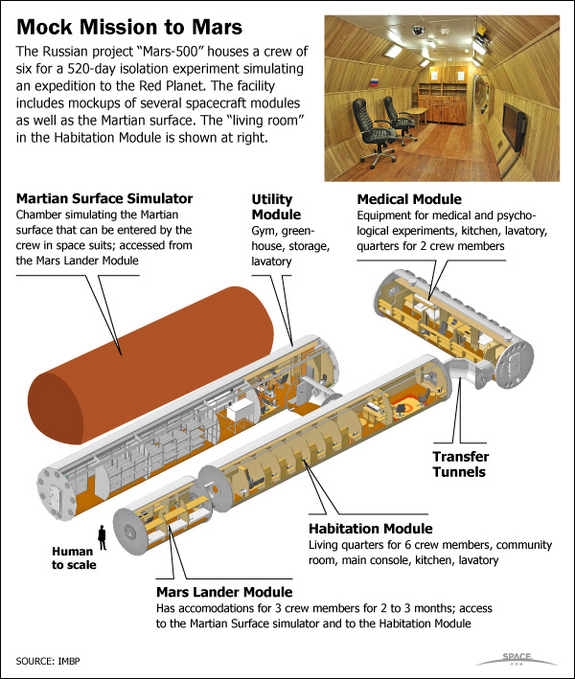In Virtual Space, Mock Mars Mission 'Arrives' at Red Planet

A 520-day attempt to simulate an entire mission to Mars has hit a major milestone, "arriving" in mock orbit around a mock Red Planet after months of virtual interplanetary flight.
The Mars500 mission "spacecraft" – actually a collection of sealed habitats in Moscow – entered a simulated orbit phase around the Red Planet on Tuesday (Feb. 1), according to the European Space Agency. Three of the craft's six crewmembers, all of whom are volunteers, will "land" on Mars on Feb. 12 to make three deployments onto simulated Martian terrain, ESA officials said.
Mars500 — a $15 million joint experiment by ESA, Russia and China — aims to study the complex psychological and technical challenges that must be solved for long spaceflights, officials have said. The project has been running for more than eight months in a mock spacecraft at the Institute of Biomedical Problems in Moscow.
"Mars500 is a visionary experiment," Simonetta Di Pippo, ESA's director for human spaceflight, said in a statement. "Europe is getting ready to make a step further in space exploration: Our technology and our science grow stronger every day. Mars500 today is only an enriching simulation, but we are working to make it real."
A simulated Mars flight
The Mars500 crew — which is made up of three Russians, two Europeans and one Chinese — has been living and working together in the Moscow facility, treating the mission like a real trip to Mars. They're each getting paid about $97,000 to participate in the mission.
The crewmembers are following a schedule similar to that experienced by astronauts aboard the International Space Station, ESA officials said. They have two days off every week, and their work time during the "flight" is filled with maintenance jobs, experiments and daily exercise.
Breaking space news, the latest updates on rocket launches, skywatching events and more!
The final approach to Mars began on Dec. 24, when the crewmembers shifted their imagined trajectory from interplanetary space to a spiral orbit leading down to the vicinity of the Red Planet, officials said.
The crew then opened a hatch between their mothership and a mockup of a lander that, according to script, was launched separately to Mars.
In the coming days, the cargo inside the lander will be transferred into the habitat and the lander will be prepared for "undocking" and "landing," officials said.
The crew will then divide: Russian Alexandr Smoleevskiy, Italian Diego Urbina and Chinese Wang Yue will enter the lander. The rest of the crew — Romain Charles of France and Russians Sukhrob Kamolov and Alexey Sitev— will remain in orbit.
'Landing' on Mars
The hatch between the interplanetary spacecraft and lander will be closed on Feb. 8. The lander will then undock and "touch down" on Mars on Feb. 12, officials said.
The first foray to explore the simulated Martian surface, housed in a large hall alongside the Mars500 modules, will happen on Feb. 14. Smoleevskiy and Urbina will don modified Russian Orlan spacesuits and exit the lander's airlock.
The next expedition – by Smoleevskiy and Wang Yue – will take place on Feb. 18 and the last one – by Smoleevskiy and Urbina – is scheduled for Feb. 22, officials said.
On Feb. 23, the lander will be launched to "orbit," and it will dock with the mothership on the following day. The lander crew will stay in quarantine for three days before the hatch is opened on Feb. 27, when the astronauts will be reunited.
A day later, the lander will be loaded with rubbish and the vehicle will be "abandoned." This will happen on March 1, just before the spacecraft spirals away from Mars by firing its virtual engines.
After that, the crew is faced with another monotonous "interplanetary cruise" before arriving home in early November 2011, officials said.

Space.com is the premier source of space exploration, innovation and astronomy news, chronicling (and celebrating) humanity's ongoing expansion across the final frontier. Originally founded in 1999, Space.com is, and always has been, the passion of writers and editors who are space fans and also trained journalists. Our current news team consists of Editor-in-Chief Tariq Malik; Editor Hanneke Weitering, Senior Space Writer Mike Wall; Senior Writer Meghan Bartels; Senior Writer Chelsea Gohd, Senior Writer Tereza Pultarova and Staff Writer Alexander Cox, focusing on e-commerce. Senior Producer Steve Spaleta oversees our space videos, with Diana Whitcroft as our Social Media Editor.

